|
Maserati Quattroporte V
Debut: 2004
Maker: Maserati
Predecessor: Quattroporte IV
|
|
 Here
it comes again. This is the 5th generation Maserati Quattroporte -
whose
name means "four doors". Its mission is to break the mould of German
luxurious
saloons and take Italy back into the luxurious car market. You might
remember
the last generation Quattroporte. Based on a stretched Bi-Turbo
platform
and finished in poor quality, it was never a commercial success. Even
after
the company was bought by Ferrari and the latter fine tuned the car in
the mid-90s, it was still far from competitive. Today, Maserati is in a
much stronger position to challenge the German. It has a modernized
factory,
a strong engineering team shared with Ferrari, a well managed quality
system
and a strong leadership by Maserati-Ferrari chairman Luca di
Montezemolo.
The first wave of revival was 4200GT. The even stronger second wave is
Quattroporte. Now it declares war to the heartland of German - high
luxurious
car segment. Here
it comes again. This is the 5th generation Maserati Quattroporte -
whose
name means "four doors". Its mission is to break the mould of German
luxurious
saloons and take Italy back into the luxurious car market. You might
remember
the last generation Quattroporte. Based on a stretched Bi-Turbo
platform
and finished in poor quality, it was never a commercial success. Even
after
the company was bought by Ferrari and the latter fine tuned the car in
the mid-90s, it was still far from competitive. Today, Maserati is in a
much stronger position to challenge the German. It has a modernized
factory,
a strong engineering team shared with Ferrari, a well managed quality
system
and a strong leadership by Maserati-Ferrari chairman Luca di
Montezemolo.
The first wave of revival was 4200GT. The even stronger second wave is
Quattroporte. Now it declares war to the heartland of German - high
luxurious
car segment.
This segment
is
currently
occupied by Mercedes S600 and S55 AMG, BMW 760i, Audi A8 W12 and Jaguar
XJR. Prices range from £76,000 to £90,000 (except XJR at
£58,000).
Horsepower range from 400hp to 500hp. All can do 0-60mph in under 5.5
sec,
but the Mercedes duo is especially lightning quick, taking only 4.6
sec.
Comparatively, Maserati’s entry into this market is a modest one. It is
priced at a reasonable £70,000. This is actually a bargain if you
consider its production volume of 4,000 units a year, in contrast to
the
tens of thousands of S-class, 7-series and A8 flowing over the market
every
year. But it offers 400 horsepower "only" and in terms of torque it
loses
out to competitors by quite a margin. Cheaper but less powerful than
its
mass-production rivals, strangely. Can it beat the German?
If you care
only
about statistics,
the Quattroporte will have no chance. But luckily, Italian cars always
sell by their soul and character. Quattroporte is undoubtedly unique in
this aspect.
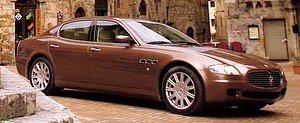 Look
at its shape ! it looks like a coupe, with flowing lines and muscular
shoulders,
in contrast to the sedan-based styling of its rivals. The sculpted nose
with classical grille delivers a sense of occasion unfound in any mass
production cars. All window frames are chromed, so are side air vents,
grilles, door handles and rear lights. This contribute to the prestige
feel. I specially enjoy the shape of C-pillar, the single-piece rear
side
windows and how they meet the pronounced rear shoulders. Look
at its shape ! it looks like a coupe, with flowing lines and muscular
shoulders,
in contrast to the sedan-based styling of its rivals. The sculpted nose
with classical grille delivers a sense of occasion unfound in any mass
production cars. All window frames are chromed, so are side air vents,
grilles, door handles and rear lights. This contribute to the prestige
feel. I specially enjoy the shape of C-pillar, the single-piece rear
side
windows and how they meet the pronounced rear shoulders.
Who
styled the
Quattroporte?
the early Quattroporte was styled by Giugiaro and the last generation
was
by Gandini. Now it finally employs Pininfarina studio, the default
choice
of Ferrari. It was penned by Pininfarina’s Ken Okuyama, the same
designer
of Ferrari Enzo and 612 Scaglietti.
If
you are a good
observer,
you will find the profile of Quattroporte is "cab-rearward". This
reveal
a very special feature of the Maserati - rearward-biased weight
distribution.
Most FR saloons have a slight front-biased weight distribution and some
achieve 50:50, but Maserati Quattroporte is the only saloon on the
market
having rear-biased weight distribution (by the way, Ferrari 612
Scaglietti
also follows this philosophy). By putting the lightweight 4.2-litre V8
completely behind the front axle, by moving the cabin rearward (as a
result
of the engine position) and by putting the gearbox at the rear axle,
the
car obtains a 47:53 weight distribution. This give it a much different
handling character from its rivals - more agile, more responsive to
steering
and less understeer.
Although
many
components
are shared with 4200GT, the Quattroporte is built on a new platform. In
fact, it will be used by the next generation 4200GT and even an
undisclosed
Audi currently under discussion. You can see how highly regarded it is.
The platform uses aluminum double-wishbones as suspensions and Skyhook
adaptive damping like the 4200GT.
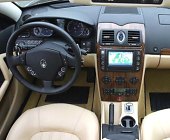 The
Quattroporte is really fun to drive. It sets new standards for big car
handling, closer to BMW M5 than 760i. Part of the reason is the firm
setting
of damping which leads to superb body control. But the main reason is
still
its chassis balance. It responds keenly to steering input. Its steering
has adequate weighting and feeds all the necessary information into
driver’s
hands and filters the unwanted harshness. It understeers at tight
corners,
but if you switch off the stability control it can powerslide like a
M5.
Just the extra length and weight denies it a position in sport sedan
market. The
Quattroporte is really fun to drive. It sets new standards for big car
handling, closer to BMW M5 than 760i. Part of the reason is the firm
setting
of damping which leads to superb body control. But the main reason is
still
its chassis balance. It responds keenly to steering input. Its steering
has adequate weighting and feeds all the necessary information into
driver’s
hands and filters the unwanted harshness. It understeers at tight
corners,
but if you switch off the stability control it can powerslide like a
M5.
Just the extra length and weight denies it a position in sport sedan
market.
The
trade-off for
good body
control is firm ride. Even in Comfort mode the damping is still too
stiff
by class standard. On smooth open road this is not a problem, but on
poor
surface the rear occupants will feel especially uncomfortable. Anyway,
Maserati’s target customers are more enthusiastic kind of drivers thus
they could be willing to accept that.
The
Quattroporte
is a very
big car. Originally it was designed to be smaller but then Montezemolo
was not satisfied with its cabin space and decided to stretch its
wheelbase
to 3064mm. The whole car measures over 5m in length. Kerb weight is
1930kg,
about the same as Mercedes S55 AMG.
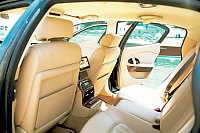 Despite
of the S-class size, cabin space is closer to E-class level. This is a
price Maserati willing to pay for the rear-biased mechanical layout.
Anyway,
the quality of the interior is first class, more expensive than any
Mercedes
on the market bar Maybach. The whole cabin is trimmed with leather. The
dashboard and instrument reading are stylishly shaped. Center console
is
a single piece of wood whose design is inspired by luxurious boats.
Beautiful
leather seats and generous list of luxurious equipment finish the
package.
This place reflects the finest Italian style and craftsmanship. More
important,
it is unique and have no mass market appeal of its rivals. Despite
of the S-class size, cabin space is closer to E-class level. This is a
price Maserati willing to pay for the rear-biased mechanical layout.
Anyway,
the quality of the interior is first class, more expensive than any
Mercedes
on the market bar Maybach. The whole cabin is trimmed with leather. The
dashboard and instrument reading are stylishly shaped. Center console
is
a single piece of wood whose design is inspired by luxurious boats.
Beautiful
leather seats and generous list of luxurious equipment finish the
package.
This place reflects the finest Italian style and craftsmanship. More
important,
it is unique and have no mass market appeal of its rivals.
Responsible
for
pulling the
car is the same engine as 4200GT. Although quoting 400hp instead of
390hp,
it is the same 4244 cc V8 with variable valve timing. Inevitably,
compare
with its large capacity, turbocharged or supercharged rivals its torque
output (332 lbft maximum) trails behind by a large margin. However, in
terms of sound quality, willingness, smoothness, revability and
throttle
response this is definitely the best V8 in the world. Moreover, in the
engine compartment of Quattroporte it is just as quiet as you want for
a driver-oriented luxurious car. Performance is adequate for the class
- Maserati claims an unlimited 171mph top speed and 0-60mph only 5.0
sec.
So, forget the nonsense German superpower twin-turbo V12, W12 or
supercharged
V8. The Italian V8 is what we want.
What we don’t
want is the
6-speed semi-automatic gearbox (now calls "DuoSelect" instead of
"Cambiocorsa").
It is made slightly smoother than the previous offering in other
Maserati
and Ferrari, and it is default at auto mode, but shift action is still
jerky in various conditions thus is totally unsuitable to a luxurious
sedan.
Why not simply employ ZF’s 6-speed automatic? Maserati’s answer is very
simple: it cannot fit as a transaxle. What a pity.
Maserati
Quattroporte has
taken a big leap in dynamics, quality and comfort while preserving its
own character - no matter strength or flaws. To me, it is the most
desirable
luxurious sedan in the world but not the most sensible purchase. With a
decent gearbox and smoother ride quality it could have become a real
winner.
Let’s hope Maserati can sort out these problems in the near future.
|
| The
above report was last updated on 13 Mar
2004. All Rights Reserved. |
Quattroporte's gearbox improved
|
No matter
what they calls, the automated manual gearboxes of Ferrari-Maserati
were
always flawed. Lightning quick they may be, but the harshness and
unpredictability
were hardly acceptable. This is especially disappointing if you
remember
Ferrari was the first car maker launching this kind of gearbox.
Recently, the
company seems
finally sorted out the problem. The F1A gearbox on Ferrari 612
Scaglietti
is praised for being smooth and refined, just next to Audi’s DSG
gearbox.
Now Maserati Quattroporte’s DuoSelect gearbox is also under surgery - a
thing it desperately needed. By upgrading the software - a result of
repeated
testing - the gearbox now shifts noticeably smoother. Now you can
finally
enjoy the marvelous engine without being disturbed by the gearbox.
In
auto mode, the
timing
of shift is also more predictable. In the past, it used to change
unexpectedly
in mid-corner and ruin the smoothness of control. Now the software is
more
sensible, understanding what the driver’s want and hold the gear in
those
circumstances. An unfussed driving is finally achieved.
With
the gearbox
upgrade,
I can finally put my vote to Maserati Quattroporte when electing the
best
luxurious sports sedan, at least until the new M5 arrive.
|
| The
above report was last updated on 9 Jul 2004. All
Rights Reserved. |
Quattroporte Sport GT
|
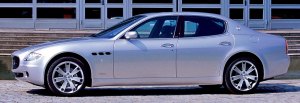
Sport GT
is the
latest improvement to the big Quattroporte. As indicated by its name,
it is the sportier version of Quattroporte, aiming at more hardcore
drivers. Modifications concentrate on 5 areas:
1) It employs aggressive 20-inch wheels (up from 18-inch) and very low
profile tires (245/35 front and 285/30 rear). The tire compound is made
specially for the car to enhance handling at the limit.
2) The Skyhook adaptive damping got revised software to control the
suspension better during hard use.
3) The semi-automatic transmission has improved program. In Sport mode,
the shift is quickened by 35% yet it becomes cleaner and smoother.
4) The brakes are now cross-drilled. Pedal feel is also improved.
5) The cabin replaced woods decoration for carbon-fiber ones. Dark
leather and drilled aluminum pedals also contribute to a serious
ambience.
As a result, the Sport GT becomes even better than before. On the road
it displays amazing agility, poise and driver involvement. The improved
damping, grip and shift quality give it the necessary refinement to
fight against BMW M5, although it is neither as powerful nor as quick.
However, the new interior delivers a bespoke feel that none of its mass
production German rivals can compare with. This is absolutely a
contender of the best performance saloon in the world. |
| The
above report was last updated on 20 Apr
2006. All Rights Reserved. |
Quattroporte Automatica
|
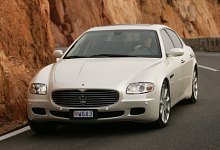 After
3 years insisting on the automated manual gearbox DuoSelect, Maserati
finally admitted most customers prefer a conventional automatic
transmission. Although DuoSelect has been improving significantly
through the years, in automatic mode it is still noticeably more jerky
than a conventional automatic transmissions simply because it uses an
automated clutch instead of a hydraulic torque converter. To Ferrari,
this does not present much problems. To the Maserati four-door luxury
saloon which targets at the same audiences as Mercedes-AMG S-class, BMW
760, Audi S8 and Jaguar XJR, customers regularly leaves the
transmission in automatic mode thus they inevitably prefer the seamless
gearshifts of its genuine automatic rivals. This forces Maserati to add
a conventional automatic option to the car. After
3 years insisting on the automated manual gearbox DuoSelect, Maserati
finally admitted most customers prefer a conventional automatic
transmission. Although DuoSelect has been improving significantly
through the years, in automatic mode it is still noticeably more jerky
than a conventional automatic transmissions simply because it uses an
automated clutch instead of a hydraulic torque converter. To Ferrari,
this does not present much problems. To the Maserati four-door luxury
saloon which targets at the same audiences as Mercedes-AMG S-class, BMW
760, Audi S8 and Jaguar XJR, customers regularly leaves the
transmission in automatic mode thus they inevitably prefer the seamless
gearshifts of its genuine automatic rivals. This forces Maserati to add
a conventional automatic option to the car.
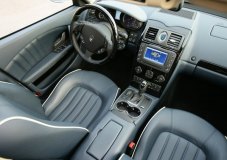 The Quattroporte Automatica
employs a 6-speed automatic made by ZF. As shown in BMW 7-Series,
Jaguar XJ and XK and Aston Martin DB9, this is the best automatic
available on the market (bear in mind that Mercedes' 7G-Tronic and
Lexus' 8-speeder are unavailable to others). However, to install it
into the Maserati takes a lot more modifications than imagined. The
original Quattroporte has its DuoSelect gearbox mounted at the rear
axle (i.e. "Transaxle") to benefit weight distribution. Unfortunately
this format does not fit the ZF automatic, thus Maserati has to move
the gearbox to the front, just behind the engine, in conventional
position. This triggers a series of modifications - the rear subframe
was redesigned; the V8 engine switched to wet sump lubrication; the cam
covers are painted in blue instead of red in order to distinguish from
that of the dry-sump / DuoSelect version. Reprogramming the engine to
suit the character of the automatic gearbox also results in a rise of
maximum torque by 7 lbft, and it arrives at 4250 rpm instead of the
previous 4500 rpm. Peak power remains changed at 400 hp, at a heady
7250 rpm. The Quattroporte Automatica
employs a 6-speed automatic made by ZF. As shown in BMW 7-Series,
Jaguar XJ and XK and Aston Martin DB9, this is the best automatic
available on the market (bear in mind that Mercedes' 7G-Tronic and
Lexus' 8-speeder are unavailable to others). However, to install it
into the Maserati takes a lot more modifications than imagined. The
original Quattroporte has its DuoSelect gearbox mounted at the rear
axle (i.e. "Transaxle") to benefit weight distribution. Unfortunately
this format does not fit the ZF automatic, thus Maserati has to move
the gearbox to the front, just behind the engine, in conventional
position. This triggers a series of modifications - the rear subframe
was redesigned; the V8 engine switched to wet sump lubrication; the cam
covers are painted in blue instead of red in order to distinguish from
that of the dry-sump / DuoSelect version. Reprogramming the engine to
suit the character of the automatic gearbox also results in a rise of
maximum torque by 7 lbft, and it arrives at 4250 rpm instead of the
previous 4500 rpm. Peak power remains changed at 400 hp, at a heady
7250 rpm.
On the road, the new gearbox brings refinement never experienced in the
previous Quattroporte. In automatic mode, apart from a slight jerk at
start up, the gearbox shifts smoothly once the car is rolling. For the
first time since its birth, the big Maserati feels relaxed to drive, as
the torque converter smoothen out the shocks in every gearshift. In
manual mode (operated by paddles behind the steering wheel), the ZF
unit still excels in upshift, but downshift is not quite as smooth as
DuoSelect because it does not make enough engine blip to match rev. Of
course, shift speed is not as instantaneous as DuoSelect, something you
have to sacrifice in exchange for smoothness. Maserati said the
Automatica sacrifices 3 mph top speed and adds 0.4 seconds to 0-60. We
have no reasons to doubt that.
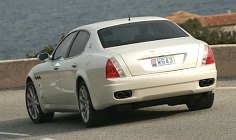 Bringing the transmission
forward moves 2 percent of the weight forward as well. But the good
news is: the Quattroporte Automatica is still slightly rear-biased at
49:51. No one else in the class can offer the same kind of agility and
steering feel. The Skyhook adaptive damping has been tuned to be
slightly softer. However, compare with the German and English highway
expresses it is still very much a hardcore machine. You won't buy it
for ride quality or sound insulation. Bringing the transmission
forward moves 2 percent of the weight forward as well. But the good
news is: the Quattroporte Automatica is still slightly rear-biased at
49:51. No one else in the class can offer the same kind of agility and
steering feel. The Skyhook adaptive damping has been tuned to be
slightly softer. However, compare with the German and English highway
expresses it is still very much a hardcore machine. You won't buy it
for ride quality or sound insulation.
Is the Automatica better suited to the Quattroporte than DuoSelect ?
most journalists think yes. However, it is still not as refined as a
proper ZF unit ought to be. Torque converters are best suited to
torquey engines. Unfortunately, the Maserati V8 locates at the other
end of the spectrum - rev-hungry, low inertia and relatively short of
torque. Paradoxically, while automatic transmission suits the character
of the big Quattroporte, it does not suit the Maserati V8. What
Maserati really needs is a double-clutch gearbox. It shouldn't take too
long. |
| The
above report was last updated on 3 Feb 2007. All
Rights Reserved. |
Quattroporte S
|
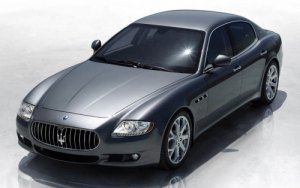 Maserati's
V8 engine could be a joy or an upset. Enthusiastic driver should be
delighted by its sound and rev-hungriness. It begs you to squeeze it
and rewards you with better sound and punch. However, when it is used
in a 2-ton luxury car like Quattroporte, they are a mismatch. Heavier
cars require more low down torque to overcome its mass. Luxury car
drivers are also biased towards effortless driving style. They want
instant punch for overtaking once they press the gas pedal, rather than
waiting for the rev to rise and working tiresomely on gearbox. A great
engine it may be, the outgoing Maserati 4.2-liter V8 is just not the
right engine for Quattroporte. Maserati's
V8 engine could be a joy or an upset. Enthusiastic driver should be
delighted by its sound and rev-hungriness. It begs you to squeeze it
and rewards you with better sound and punch. However, when it is used
in a 2-ton luxury car like Quattroporte, they are a mismatch. Heavier
cars require more low down torque to overcome its mass. Luxury car
drivers are also biased towards effortless driving style. They want
instant punch for overtaking once they press the gas pedal, rather than
waiting for the rev to rise and working tiresomely on gearbox. A great
engine it may be, the outgoing Maserati 4.2-liter V8 is just not the
right engine for Quattroporte.
The introduction of a 4.7-liter version of the V8 could solve this
problem. This engine has been used in Alfa Romeo 8C Competizione and
Maserati GranTurismo S. In the Quattroporte its output rating is 430
horsepower at 7000 rpm (30hp up) and 361 lb-ft of torque at 4750 rpm
(22 lb-ft up). Although the max torque sounds even peakier than the old
engine, in reality the new V8 is much more tractable, thanks to a
flatter torque curve. From 2400 rpm, there is at least 82 percent of
the maximum torque (i.e. 296 lb-ft) available for exploit. While it
still can't match the larger capacity German performance luxury cars
like Mercedes S63 AMG or Audi S8, its performance is satisfyingly
accessible to the extent that you can now really enjoy it without
turning on your racing mood. Of course, if you want fun, you will still
find the Maserati V8 far more charismatic than those torque-biased
German engines, because its rev-eagerness remains untouched.
Officially, the 4.7-liter engine is used only in the new range-topping
model Quattroporte S (just like GranTurismo S), but we all know the old
4.2 engine is phasing out, so expect all Quattroporte versions will use
the new engine very soon. A similar story goes for the old automated
manual transmission. Even the new range topper employs the superb ZF
automatic transmission mounted right behind the V8.
Apart from engine, all Quattroporte gets a subtle facelift which
consists of a more classical grille (like GranTurismo), new LED
headlights and taillights and restyled bumpers. I am always a fan of
its Pininfarina styling, so the new car continues to be my favourite
luxury car design. In the cabin, there are some upgraded infotainment
equipments, but I suppose you won't be interested to read them.
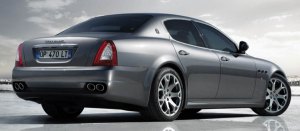 In the
chassis, the Skyhook adaptive damping (standard on S and optional in
lesser models) has been tuned softer, so the new car rides smoother and
quieter. Like the engine, its ride quality is still no match to the
best German machines, but it is far more livable now so that you can
take ride quality out of its fault list. In the
chassis, the Skyhook adaptive damping (standard on S and optional in
lesser models) has been tuned softer, so the new car rides smoother and
quieter. Like the engine, its ride quality is still no match to the
best German machines, but it is far more livable now so that you can
take ride quality out of its fault list.
As before, the best part of Quattroporte is its neutral handling,
thanks to 49:51 weight distribution. It has an excellent dynamic
balance that its German rivals could only dream of. This balance also
benefits its steering, which is accurate and linear yet lightweight. No
other cars so big could be placed so accurately on narrow mountain
roads.
The Quattroporte S has corrected the biggest faults of the old car -
lack of torque and harsh ride - and keeps excelling in handling. Its
engine character, design and packaging are exclusive in the market.
Although it is not the fastest performance luxury car, it is definitely
the most desirable. |
| The
above report was last updated on 15 Jul
2008. All Rights Reserved. |
Quattroporte Sport GTS
|
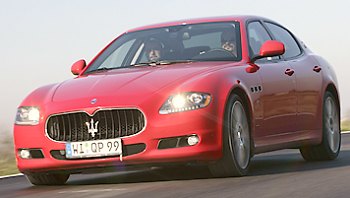 Sometimes
I am quite tired of writing about different incarnations of Maserati
Quattroporte. Frankly, they do not differ a lot from each other, and
their names usually fail to characterize them. Maserati often abused
the words Sport (S) and Gran Turismo (GT) so that you can’t figure out
what characters they represent. The latest generation of Quattroporte –
since the larger 4.7-liter engine was introduced – consists of two
models, S and Sport GTS. To other manufacturers, S should be reserved
for the more sporting model, but here in Modena it is used to represent
the regular, more comfort-biased Quattroporte. It is equipped with
Skyhook adaptive damping, standard suspension and 18-inch wheels. Sometimes
I am quite tired of writing about different incarnations of Maserati
Quattroporte. Frankly, they do not differ a lot from each other, and
their names usually fail to characterize them. Maserati often abused
the words Sport (S) and Gran Turismo (GT) so that you can’t figure out
what characters they represent. The latest generation of Quattroporte –
since the larger 4.7-liter engine was introduced – consists of two
models, S and Sport GTS. To other manufacturers, S should be reserved
for the more sporting model, but here in Modena it is used to represent
the regular, more comfort-biased Quattroporte. It is equipped with
Skyhook adaptive damping, standard suspension and 18-inch wheels.
Sport GTS, on the other hand, comes with fixed rate dampers, sport
suspension (30 and 10% stiffer front and rear respectively) and 20-inch
wheels. Its rear tires are 10mm wider. Its V8 gets a two-stage exhaust
system to boost peak power by 10hp, or a total of 440 hp. This reduces
0-60 mph to 5.1 seconds. Its ZF 6-speed automatic transmission comes
with more aggressive control strategy, including a launch mode called
“MC Start” that cuts 0-60 mph a further 0.2 seconds. In short, Sport
GTS is more driver-oriented than the S model.
On the road, Sport GTS does sacrifices some ride comfort, inevitably.
It is pretty firm, but not harsh by the standard of sports saloons
(think of BMW M5 or Audi RS6), thanks to the well-judged damping. In
straight line, you will be hard to detect the additional horsepower
from the g-force – after all, it represents only 2 percent of the total
output. However, your ears will tell you it IS faster, because once the
exhaust bypass valves open under sport mode, you hear a deep, throaty
exhaust note that few engines can compare with. As we always say, it
doesn’t matter whether the car is really fast. What matters is whether
it feels fast.
The Sport GTS not only feels fast through your ears, but also through
the responsive transmission, whose shift strategy is again an
improvement from the previous iteration. Manual mode gives you
instantaneous response like a robotized manual gearbox – no wonder
Maserati has abandoned the old DuoSelect. It does what it is supposed
to – no computer intervention except blipping throttle at downshift to
match rev beautifully. In Auto mode, it shifts as smoothly as any
automatic.
As always, the most special thing about Quattroporte is how agile it
corners. With only 49 percent of the car’s weight acting on the front
axle, and lower polar moment of inertia than any BMWs, you won’t be
surprised to see the car display responsive turn-in with a light and
accurate steering, and keep a neutral attitude way beyond rivals. The
stiffer suspension of Sport GTS only makes it more capable, easier to
keep up with its more powerful rivals. With a character more sporting
than touring, now we understand why its name consists of two “Sport”
and one “GT”. |
| The
above report was last updated on 22 May
2009. All Rights Reserved. |
|
|